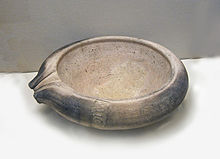209:
138:
33:
157:", and with coarse sand or grit embedded into the internal surface. They were used for pounding or mixing foods and are an important indicator of the spread of Romanized food preparation methods. Stamps on some early Roman mortaria record the name of the potter, from which it is possible to trace their movement between workshops. Some vessels produced in
176:
The
English word mortar derives from classical Latin mortarium, meaning, among several other usages, "receptacle for pounding" and "product of grinding or pounding". From
168:
Many fancy red mortaria had a small hole near the top to allow the discharge of liquids, which was artistically made to appear as the mouth of a lion, mouse, or bat.
250:
189:
105:
77:
124:
62:
84:
269:
243:
58:
91:
279:
54:
73:
236:
43:
17:
47:
208:
150:
274:
8:
98:
177:
224:
220:
153:
kitchen vessels. They are "hemispherical or conical bowls, commonly with heavy
263:
165:
are transported long distances but local factories dominate at most periods.
216:
137:
141:
Mortarium with simple pouring spout, made in
Britain, 1st century AD.
32:
154:
158:
162:
261:
244:
61:. Unsourced material may be challenged and
251:
237:
125:Learn how and when to remove this message
136:
149:(pl. "mortaria") was one of a class of
14:
262:
203:
59:adding citations to reliable sources
26:
24:
25:
291:
195:
207:
31:
13:
1:
223:. You can help Knowledge by
171:
7:
10:
296:
202:
183:
219:–related article is a
142:
270:Ancient Roman pottery
151:Ancient Roman pottery
140:
55:improve this article
280:Ancient Rome stubs
143:
232:
231:
178:mortar and pestle
135:
134:
127:
109:
16:(Redirected from
287:
253:
246:
239:
211:
204:
130:
123:
119:
116:
110:
108:
67:
35:
27:
21:
295:
294:
290:
289:
288:
286:
285:
284:
260:
259:
258:
257:
200:
198:
186:
174:
131:
120:
114:
111:
68:
66:
52:
36:
23:
22:
15:
12:
11:
5:
293:
283:
282:
277:
272:
256:
255:
248:
241:
233:
230:
229:
212:
197:
196:External links
194:
193:
192:
185:
182:
173:
170:
133:
132:
39:
37:
30:
9:
6:
4:
3:
2:
292:
281:
278:
276:
273:
271:
268:
267:
265:
254:
249:
247:
242:
240:
235:
234:
228:
226:
222:
218:
213:
210:
206:
205:
201:
191:
188:
187:
181:
179:
169:
166:
164:
160:
156:
152:
148:
139:
129:
126:
118:
115:November 2013
107:
104:
100:
97:
93:
90:
86:
83:
79:
76: –
75:
71:
70:Find sources:
64:
60:
56:
50:
49:
45:
40:This article
38:
34:
29:
28:
19:
225:expanding it
217:Ancient Rome
214:
199:
175:
167:
146:
144:
121:
112:
102:
95:
88:
81:
69:
53:Please help
41:
275:Kitchenware
74:"Mortarium"
264:Categories
85:newspapers
172:Etymology
147:mortarium
42:does not
190:Potsherd
18:Mortaria
184:Sources
155:flanges
99:scholar
63:removed
48:sources
101:
94:
87:
80:
72:
215:This
159:Italy
106:JSTOR
92:books
221:stub
163:Gaul
161:and
78:news
46:any
44:cite
57:by
266::
180:.
145:A
252:e
245:t
238:v
227:.
128:)
122:(
117:)
113:(
103:·
96:·
89:·
82:·
65:.
51:.
20:)
Text is available under the Creative Commons Attribution-ShareAlike License. Additional terms may apply.
